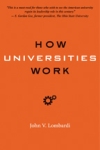Never ones to shy away from taking a cue from others, we asked several experts on higher education to comment on NPR’s ongoing series, Paying for College. Today’s installment features John V. Lombardi, author of How Universities Work, on why the cost of higher education to students and families continues to grow and what the near-term future may hold.
It is popular to present college as an out-of-control expense machine, but the data do not support such a dramatic conclusion. Instead, college costs have increased in some categories such as student support and other mid-level administrative positions related to computing and other services. Costs have stayed more or less level for full-time tenure track faculty, and they have declined for non-tenure track faculty. The most dramatic changes in college price to students and their families have come instead from the shift in sources of revenue for public higher education. As states have had to reduce spending on college to support the required expenses of health care, law enforcement and prisons, social services, and basic infrastructure, students and their families have had to pay increasingly higher proportions of the cost of a quality education. Some imagine that it is possible to provide much cheaper forms of higher education, and that may well be true, but for the most part, parents seek high-quality higher education if given any choice at all. Indeed, much of the hue and cry about the price of higher education is a function of the consuming public seeking high quality at a subsidized lower cost.
Government, from Washington to the state houses across the country, want to shift the conversation to the campuses and demand that they provide a cheaper education that does not require as much expenditure of either public money or personal income. Over the last decade, as the data clearly show, universities have done much to restrain increases in the cost of higher education per student, and for the academic component of a college education, there has been almost no increase in the cost per student.
Some of the readjustments anticipated, however, are likely to exaggerate the current distinctions among the different sectors of higher education, separating out the employment training, vocationally-oriented post-secondary programs from the four-year-plus masters or professional programs, which are in turn separated from the elite colleges and universities in the public and private sector. Consumer demand will preserve the elite much as they are today, even with rising prices to students, moderated by various complex forms of financial aid. The middle level institutions will continue to provide a mix of vocationally-oriented programs and curricula designed to prepare students for graduate and professional training beyond the college degree. Other institutions, from community colleges to many current public and private four-year liberal arts institutions, will concentrate more and more on narrowly focused, quick, effective, less-expensive programs, aimed at direct and immediate post-graduation employment in fields with specific job requirements.
Simple answers and analysis about America’s incredibly diverse and complex higher education enterprise are rarely very helpful even if they fulfill an appetite for imagined catastrophic crises.
 A regular contributor to Inside Higher Ed, John V. Lombardi is the author of How Universities Work. He has held a number of key leadership roles in higher education, including president of the Louisiana State University System, chancellor of University of Massachusetts Amherst, president of the University of Florida, and provost and vice president for Academic Affairs at Johns Hopkins University.
A regular contributor to Inside Higher Ed, John V. Lombardi is the author of How Universities Work. He has held a number of key leadership roles in higher education, including president of the Louisiana State University System, chancellor of University of Massachusetts Amherst, president of the University of Florida, and provost and vice president for Academic Affairs at Johns Hopkins University.
Our previous installments in this series include a Q & A overview of the issue with John R. Thelin and Laura W. Perna’s comments on what the declining affordability of college means for the socio-economic stratification of American society.

